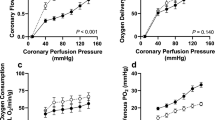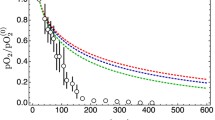Abstract
The objective of this investigation was to aid in the determination of the mechanism by which oxygen consumption changes in proportion to coronary perfusion pressure or coronary blood flow. A mathematical model of oxygen transport and consumption in the isolated-perfused heart was developed, based on data from an autoregulating, cell-free perfused, externally paced, isovolumic feline heart preparation. The model features the unique combination of Michaelis-Menten kinetics, and one-dimensional (axial) diffusion in radially well-mixed tissue. An adaptive finite-difference integration routine was used to solve the resulting third order stiff two-point boundary value problem. A simplex minimization was employed to determine the parameter values that minimized the squared difference between the model and the experimental data in terms of tissue PO2 distribution (histograms). Different cases of the model representing pressure-induced, flow-induced, and “magnified” flow effects were run. The flow-dependent oxygen consumption version of the model produced a histogram squared error 30% lower than the pressure-induced version and 5% lower than any other case. The model and a critical review of the literature indicate that a flow-related mechanism is responsible for this phenomenon. Evidence also demonstrates that the Michaelis-Menten kinetics constant is not constant for different oxygen tensions.
Similar content being viewed by others
References
Abel, R.M.; Reis, R.L. Effects of coronary blood flow and perfusion pressure on left ventricular contractility in dogs. Circ. Res. 28:961–971; 1970.
Arnold, G.; Kosche, F.; Miessner, E.; Neitzert, A.; Lochner, W. The importance of the perfusion pressure in the coronary arteries for the contractility and the oxygen consumption of the heart. Pflugers Archiv. 299:339–356; 1968.
Arnold, G.; Morgenstern, C.; Lochner, W. The autoregulation of the heart work by the coronary perfusion pressure. Pflugers Archiv. 321:34–55; 1970.
Bacaner, M.B.; Lioy, F.; Visscher, M. Induced change in heart metabolism as a primary determinant of heart performance. Am. J. Physiol. 209(3):519–531; 1965.
Bacaner, M.B.; Lioy, F.; Visscher, M. Coronary blood flow, oxygen delivery rate and cardiac performance. J. Physiol. 216:111–127; 1971.
Bassingthwaighte, J.B.; Yipintsoi, T.; Harvey, R.B. Microvasculature of the dog left ventricular myocardium. Microvasc. Res. 7:229, 1974.
Berne, R.M.; Rubio, R. Coronary circulation. In: Berne, R.M.; Sperelakis, N. eds. Handbook of Physiology: The Cardiovascular System. Washington, D.C.: Am. Physiol. Soc., sect. 2, vol. I, Chapt. 25, 1980: pp. 873–952.
Cronk, J.W.; Schubert, R.W. Michaelis-Menten-like kinetics in the Krogh tissue cylinder. In: Bruley, D.F.; Bicher, H.I.; Reneau, D.D., eds. Oxygen transport to tissue-VI. New York: Plenum Press; 1985: pp. 499–510.
Daniell, H.B. Coronary flow alterations on myocardial contractility, oxygen extraction, and oxygen consumption. Am. J. Physiol. 225(5):1020–1025; 1973.
Feigl, E.O. Coronary physiology. Physiol. Rev. 63(1):1–205; 1983.
Fisher, V.J.; Martino, R.A.; Harris, R.S.; Kavaler, F. Coronary flow as an independent determinant of myocardial contractile force. Am. J. Physiol. 217(4):1127–1133; 1969.
Fletcher, J.E. Mathematical modeling of the microcirculation. Math. Biosci. 38:159–202; 1978.
Fletcher, J.E.; Schubert, R.W. Diffusional coupling in perfused capillary-tissue structures. In: Lübbers, D.W.; Acker, H.; Leniger-Follert, E., eds. Oxygen transport to tissue-VI. New York: Plenum Press; 1983.
Garfinkel, D.; Fegley, K.A. Fitting physiological models to data. Am. J. Physiol. 246:R641–650; 1984.
Gladwell, I. A survey of subroutines for solving boundary value problems in ordinary differential equations. In: Gladwell, Sayers, eds. Computational techniques for ordinary differential equations. New York: Academic Press; 1980: pp. 273–303.
Gregg, D.E.. Regulation of the collateral and coronary circulation of the heart. Circulation. Oxford: Blackwell Scientific Publications; 1958.
Gregg, D.E.. Effect of coronary perfusion pressure or coronary flow on oxygen usage of the myocardium. Circ. Res. 13:497–500; 1963.
Kahler, R.L.; Braunwald, E.; Kelminson, L.I.; Kedes, L.; Chidsey, C.A.; Segel, S. Effect of alterations of coronary blood flow on the oxygen consumption of nonworking heart. Circ. Res. 13: 501–509; 1963.
Kreuzer, F. Oxygen supply to tissues: The Krogh unit and its assumptions. Experientia. 38:1415–1426; 1982.
Krogh, A. The rate of diffusion of gases through animal tissues with some remarks on the coefficient of invasion. J. Physiol. (London). 52:391; 1918.
Lentini, M.; Peyrera, V.. An adaptive finite difference solver for nonlinear two-point boundary problems with mild boundary layers. SIAM J. Num. Anal. 14:91–111; 1979.
Leonard, E.F.; Jorgensen, S.B. The analysis of convection and diffusion in capillary beds. Ann. Rev. Biophys. Bioeng. 3:293–339; 1974.
Mattiazzi, A.R.; Congolani, H.E.; deCastumam, E.S. Relationship between calcium and hydrogen ions in heart muscle. Am. J. Physiol. 237(4):H497-H503; 1979.
McGilvrey, R.W. Biochemistry. Philadelphia: W.B. Saunders Co; 1970.
Morgenstern, C.; Holjes, U.; Arnold, G.; Lochner, W. The influence of coronary pressure and coronary flow on the intracoronary blood volume and geometry of the left-ventricle. Pflugers Archiv. 340:101–111; 1973.
Napper, S.A. A mathematical model of oxygen transport in isolated heart. Ph.D. Dissertation, Louisiana Tech University; 1985.
Neely, J.R.; Liebermeister, H.; Battersby, E.J.; Morgan, H.E. Effect of pressure development on oxygen consumption by isolated rat heart. Am. J. Physiol. 212(4):804–814; 1967.
Neely, J.R.; Whitmer, J.T.; Rovetto, M.J. Effect of coronary blood flow on glycolytic flux and intracellular pH in isolated rat hearts. Circ. Res. 37:733–741; 1975.
Nelder, J.A.; Mead, R. A simplex method for functional minimization. Computer J. 7:308; 1965.
Olsen, C.O.; Attarian, D.E.; Jones, R.N.; Hill, R.C.; Sink, J.D.; Lee, K.L.; Wechsler, A.S. The coronary pressure-flow determinants of left ventricular compliance in dogs. Circ. Res. 49:856–865; 1981.
Opie, L.H. Coronary flow rate and perfusion pressure as determinants of mechanical function and oxidative metabolism of isolated perfused rat heart. J. Physiol. 180:529–541; 1965.
Pittman, R.N.; Okusa, M.D. Measurements of oxygen transport in single capillaries. In: Bicher, H.I.; Bruley, D.F., eds. Oxygen transport to tissue-IV. New York: Plenum Press; 1982: pp. 539–553.
Rose, C.P.; Goresky, C.A. Interactions between capillary exchange, cellular entry, and metabolic sequestration processes in the heart. In: Renkin, E.; Geiger, S., eds., Handbook of Physiology. Washington, DC: Vol. 4(2), Am. Physiol. Soc.: 1982.
Salisbury, P.F.; Cross, C.E.; Rieben, P.A. Influence of coronary artery pressure upon myocardial elasticity. Circ. Res. 8:794–800; 1960.
Salisbury, P.F.; Cross, C.E.; Rieben, P.A. Intramyocardial pressure and strength of left ventricular contraction. Circ. Res. 10:608–623; 1962.
Scharf, S.M.; Bromberger-Barnea, B. Influence of coronary flow and pressure on cardiac function and coronary vascular volume. Am. J. Physiol. 224(4):918–925; 1973.
Schubert, R.W. A physiological and mathematical study of oxygen distribution in the autoregulating isolated heart. Ph.D. Dissertation, Case Western Reserve University; 1976.
Schubert, R.W. Myocardial microvascular shunting: Relationship of tissue PO2 and venous PO2. Fed. Proc. 37(4):241; 1978.
Schubert, R.W.; Fletcher, J.E.; Reneau, D.D. An analytical model for axial diffusion in the Krogh cylinder. In: Bruley, D.F.; Bicher, H.I.; Reneau, D.D., eds. Oxygen transport to tissue-VI. New York: Plenum Press; 1984: pp. 433–442.
Schubert, R.W.; Whalen, W.J.; Nair, P. Myocardial PO2 distribution: Relationship to coronary autoregulation. Am. J. Physiol. 234(4):H361-H370; 1978.
Schuchhardt, S.; Losse, B. Static and dynamic behavior of local oxygen pressure in the myocardium. 7th European Conf. Microcirculation, Aberdeen 1972, Part I. Bibl. Anat. No. 11:164–168; 1973.
Schwefel, H.P. Numerical optimization of computer models. Great Britain: John Wiley and Sons; 1981.
Templeton, G.H.; Wildenthal, K.; Mitchell, J.H. Influence of coronary blood flow on left ventricular contractility and stiffness. Am. J. Physiol. 223(5):1216–1220; 1972.
Weisfeldt, M.L.; Shock, N.W. Effect of perfusion pressure on coronary flow and oxygen usage of nonworking heart. Am. J. Physiol. 218(1):95–101; 1970.
Whalen, W.J. Intracellular PO2 in heart and skeletal muscle. Physiologist. 14:69–82; 1971.
Wilson, D.F.; Erecinska, M.; Silver, I.A. Metabolic effects of lowering oxygen tension in vivo. In: Bicher, H.I.; Bruley, D.F., eds. Oxygen transport to tissue-IV. New York: Plenum Press; 1982: pp. 293–301.
Author information
Authors and Affiliations
Rights and permissions
About this article
Cite this article
Napper, S.A., Schubert, R.W. Mathematical evidence for flow-induced changes in myocardial oxygen consumption. Annals of Biomedical Engineering 16, 349–365 (1988). https://doi.org/10.1007/BF02364623
Received:
Issue Date:
DOI: https://doi.org/10.1007/BF02364623




